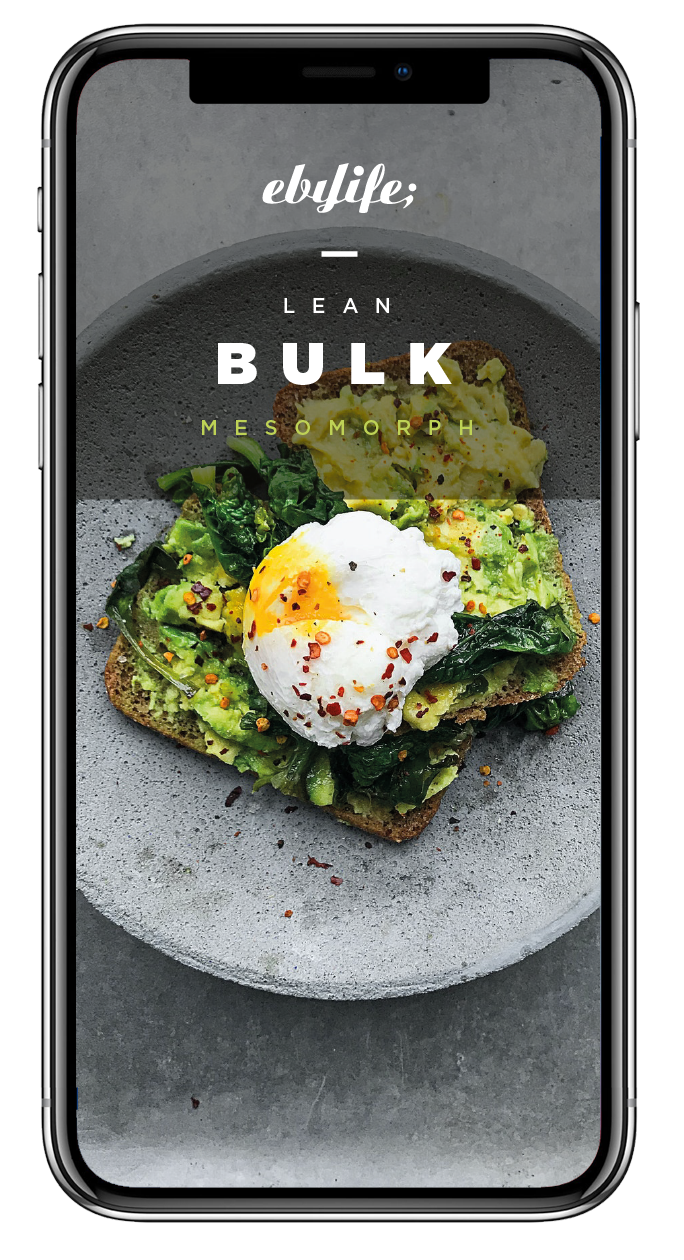Clean Bulking vs Dirty Bulking: Which is best for muscle growth?
What is Bulking?
If you are somewhat new to bodybuilding lingo, there's a word, "bulking" that you may have heard but wonder what it means. It usually refers to a gradual increase in the number of calories you take in combined with intense weight training. Any calorie intake beyond what your body needs to maintain your current bodyweight is a calorie surplus that your body can then use to build muscle.
Some people claim that bulking is unhealthy because it can lead to fat gain. However, if done right, it’s not only safe, it’s one of the most effective methods for gaining muscle mass. Especially if you consult a personal trainer, registered dietician or the trained staff at your gym, you can be sure that your exercise plan will use those extra calories for muscle-building. They can help you design a meal plan that balances the "macros" ensuring you get the right amounts of protein, carbs, and healthy fats. By slowly increasing your calorie intake and upping the intensity of your resistance training, you can ensure that your weight gain is from more lean muscle, not more body fat!
See related: The Skinny Guy Bulk up guide: Count Macros not Calories!
Bulking Diets
While eating large amounts of food may sound like a dream come true for many of us, it is difficult to just gain lean muscle without excess fat gain. As I mentioned, a caloric surplus is required, however, the type of food you eat is very important too. Your food choices will determine if you are following a clean bulking diet or a dirty bulking diet.
A dirty bulk diet typically involves eating a lot of extra calories from high-calorie foods, like junk food, fast food, and processed foods with saturated fats to promote quick weight gain. A clean bulk uses a more moderate increase in calories in addition to healthier food choices. Also called lean bulking, clean bulking encourages eating "clean foods." That means high-quality, healthy foods that are calorie-dense, but are also nutrient-dense foods. Of course you can still have some ice cream when clean bulking, just don't eat ONLY ice cream!
Which is better? A study published by the National Institutes of Health, Effect of Nutritional Intervention on Body Composition and Performance in Elite Athletes, compared the results of each diet. Two groups of athletes were asked to increase their calorie intake by 500 calories/day. One group received nutritional guidance to ensure that they not only got enough calories, but also enough protein, carbohydrates, and healthy fats, i.e. the "macronutrients." The other group was told to "have at it." Both groups gained weight, but the nutritionally guided group, the clean bulkers, gained twice as much as the have-at-it group, the dirty bulkers, and for the clean bulkers much more of that weight gain was muscle mass. In fact, nearly 72% of total weight gain in the clean bulking group was muscle mass.
Another study, reported in the Journal of the American Medical Association, Effect of Dietary Protein Content on Weight Gain, Energy Expenditure, and Body Composition During Overeating, followed three groups who were fed an extra 1,000 calories a day to promote weight gain, with varying amounts of protein at either 5%, 15%, or 25% of their calories. During this period of time, all three of the groups gained weight and muscle mass, but the low protein group gained significantly less.
While increased calories were a clear supporter of increased muscle growth in these studies, protein intake is also an important factor. Getting enough protein is crucial to gaining lean muscle mass because the amino acids in the protein you eat are the building blocks of all your muscles. Without getting enough protein, gaining muscle is difficult to do.
Still not sure what to eat? Fear not! We’ve created the ultimate bulk-up meal plan to help you reach your muscle-building potential.
The Ultimate Bulk-up Diet Plan
Welcome to the ultimate Bulk-Up diet plan for skinny guys.
What’s included in the diet plan:
✔ A fully comprehensive and easy-to-follow 7-day food plan (To be repeated until you reach your ideal weight and/or results).
✔ A carefully calculated calorie surplus, macronutrient split and precise measurements to maximize weight gain and encourage muscle growth for Skinny guys.
✔ 2 Delicious post-workout smoothie recipes to help fuel your gains.
✔ A weekly grocery list and instructions.
✔ A sample workout from our 5-day split bulk-up workout plan for skinny guys.
✔ Combines perfectly with all of our Skinny Guy bulk-up workout plans.
This diet plan is perfect for Ectomorphs and ‘hardgainers’ looking to build muscle and gain weight.
The file is in PDF format and is compatible with all phones, computers, and tablets.
Cutting Phase
As I pointed out in the studies above, 72% of the clean bulking study group's weight gain was from muscle growth. And while that's good, there's the matter of the other 28%. Yup, bulking comes with a price: fat gain. While the amount of fat you gain is somewhat under your control, it's inevitable that you're going to have to have a weight loss or better still, a fat loss (cutting) phase. This is why I recommend clean bulking over dirty bulking. Besides throwing your cholesterol out of whack, a dirty bulk diet is more likely to lead to a higher excess fat gain.
After four to six months of bulking, it's time to reverse that fat gain. Cutting, or the fat loss phase, refers to a gradual decrease in calorie intake and increase in aerobic training to reduce excess body fat from the bulking phase. This is not only healthy, it helps show off the amount of muscle you've gained by improving muscle definition.
A Healthline.com article, What Is Bulking? Steps, Diet, and More, states that a review of bodybuilders diets found the average calorie intake for men and women during the bulking phase and during the cutting phase. Of course, one's body composition, goals, and lifestyle are going to play a major role in your food choices.
For men (on average) I recommend:
Bulking: 3,500 calories per day
Cutting: 2,000 calories per day
For women (on average) I recommend:
Bulking: 2,800 calories per day
Cutting: 1,500 calories per day
Again, it’s important to understand that there are a great deal of factors such as body type and composition, age, goals, exercise intensity and frequency etc that will determine your calorie requirements when bulking and cutting, but you can use these figures above as a rough guide.
For more info on body types See:
Male Body Types: How best to train, eat and supplements for your body type
Female Body types: How best to eat, train and supplement for your body type
Cardio During Cutting
Doing cardio is often one of the keys to the fat loss part of your cutting phase. Many worry that doing too much cardio may actually result in muscle loss. While this is more true for some than others, most folks can burn off their excess fat gain without too much muscle loss. Both moderate intensity steady-state cardio and High Intensity Interval Training (HIIT) are great ways to lose the fat while maintaining muscle mass.
Steady-state cardio sessions tend to be quite long and monotonous, while HIIT is relatively short, usually around 15-20 minutes, and has been shown to burn calories more effectively than lower-intensity, longer-duration cardio. This is because HIIT combines slow-medium paced intervals with higher intensity bursts. If you have a favorite sport, cycling, rowing, running, even jumping-rope, you can work out a HIIT regimen using it. Let's say you are into using a rowing machine, here's what you can do:
Warm-Up for 5 minutes or so.
Row for one minute at 60-75% of your max heart rate.
Row for 30 seconds at 90-95% of your max heart rate.
Repeat 10 times for a total of 15 minutes.
Cool Off for 5 minutes or so.
If you prefer a different form of exercise, simply substitute it in the above formula. In less than a half-hour, you've burned a bunch of calories from body fat, strengthened your heart, and enjoyed one of your favorite activites!
Or you can make up your own HIIT workout utilizing any of the many heart-pumping exercises in existence. This particular plan requires no equipment and also helps train the upper body:
Push-ups (20 seconds)
Rest (10 seconds)
High knees (20 seconds)
Rest (10 seconds)
Mountain climbers (20 seconds)
Rest (10 seconds)
Push-ups (20 seconds)
Rest (10 seconds)
Jump squats (20 seconds)
Rest (10 seconds)
Plank jacks (20 seconds)
Rest (10 seconds)
Burpees (20 seconds)
Rest (10 seconds)
Push-ups (20 seconds)
Rest (10 seconds)
I recommend doing HIIT or steady state cardio 1-2x per week during the cutting phase. There is a benefit of doing this in the morning after waking up, if it fits in your lifestyle/schedule. This is because carbohydrate and Gylcogen stores are low upon waking up, therefore your body will more likely utilize fat for energy. Yes, doing cardio in the morning fasted can be a little worse for muscle loss, but the amount of fat you lose will far outweigh the amount of muscle you lose. If in doubt, you can take a BCAA or pre workout supplement before your workout for a little extra muscle protection. Make sure to eat a decent meal or a protein shake afterwards too!
Keep in mind, though, that during the cutting phase, you're going to have less energy because you're reducing calories. Make sure when doing HIIT, you start slow and build up as your body adapts to the high intensity training. This will prevent overtraining and/or injury.
Weightlifting During Cutting
Remember that the primary goal of the cutting phase is weight loss, not muscle-building. However, as long as you don't attempt to continue to smash PBs, weight training is highly beneficial to your goal of fat loss while maintaining your heard-earned muscle growth. As I said above, you'll have less energy, so take it easy (ier) to avoid burnout/injuries.
I recommend that you focus on the large muscles and use compound exercises. This will burn more calories. Also, be sure to keep your heart-rate up while working out. Below is a set of exercises that fit the bill. This regimen uses dumbbells and exercises all the major muscle groups. Do each exercise for 20 seconds, then rest for 10. Do each exercise for 8 rounds and a total 4 minutes. Then rest for 2 minutes and move onto the next exercise.
Dumbbell Goblet Squat: Squats naturally increase growth hormone, which boosts overall testosterone levels for good muscle maintenance.
Single Arm Dumbbell Row: This exercise works your upper body, especially your back. It strengthens your biceps, shoulders, and can be used to even out strength imbalances. Lower the weight slowly, keeping your muscles under tension while concentrating on contracting your back muscles during every rep.
One Arm Dumbbell Swing: This exercise can be done with a kettle bell also. It combines momentum and muscle control to target your hamstrings and glutes. But, with proper form, this move will also activate your lower back, quadriceps and shoulders.
Dumbbell Lunge: Working one leg at a time wipes out muscle imbalances, ramps up your calorie burn and boosts testosterone levels. Focus on keeping your knees stable to minimize your risk of injury.
Incline Dumbbell Press: The incline activates your front deltoids (shoulders) and also targets the stubborn upper chest muscles to ensure that your pecs are even. Less is more with this exercise. Smoother reps with lighter dumbbells are better than "going for broke!" This allows for greater muscle growth of the upper chest when the exercise is performed regularly.
Renegade Row: This is a multi-joint exercise that engages your core and upper body. The instability created when you enter a 3-point position with one arm off the ground engages your core while working your back, shoulders, triceps, and biceps.
What to Eat
A typical clean bulking diet uses the 50:30:20 rule for macronutrients. That means that roughly half your calories should come from carbs, 30% from protein, and 20% from healthy fats. Eating whole foods, rather than processed foods or junk food will go a long way to helping you reach your fitness goals. Remember that getting enough protein will help maintain your muscle gains while helping reduce your overall body fat. I recommend that you get about:
45–60% (50) of your calories from carbs
30–35% (30) of your calories from protein
15–30% (20) of your calories from fat
Carbs and protein each contain about 4 calories per gram, while fat contains about 9 calories per gram. So using the example from above, a man who is bulking at the recommended level of 3800 calories per day would eat about:
475 grams of carbs (50% of 3800 divided by 4)
285 grams of protein (30% of 3800 divided by 4)
85 grams of fat (20% of 3800 divided by 9)
You can use calorie-tracking apps to help you stay within your calorie budget and macronutrient range. Below is a list of healthy foods to include in your clean bulk diet:
Lean proteins: chicken, fish, turkey, beef, pork, Greek yogurt, cottage cheese, reduced fat cheese, protein powders, whey, tofu and tempeh, and eggs and egg whites.
Healthy fats: olive oil, avocado, nuts, nut butters, fatty fish, and seeds like chia, hemp, and flax seeds.
Legumes: all beans, including chickpeas and kidney, navy, black, and great northern beans.
High-quality carbs: oats, quinoa, whole grain pasta, white and sweet potatoes, and white and brown rice, whole grains.
Fruit: apples, oranges, bananas, pineapple, grapefruit, and all types of berries.
Non-starchy veggies: peppers, asparagus, green beans, mushrooms, onions, tomatoes, zucchini, carrots, and celery.
Cruciferous veggies: broccoli, cauliflower, Brussels sprouts, and cabbage.
Dark leafy greens: spinach, Swiss chard, collard greens, and kale.
Beverages: water, seltzer, tea, coffee, and kombucha
Still scratching your head? Fear not! We’ve got you covered with our carefully designed Lean bulk meal plan for Mesomorphs.
Lean Bulk for Mesomorphs diet plan
Welcome to Lean BULK for Mesomorphs. The perfect meal plan for men with a medium-sized body shape looking to pack on some serious lean muscle whilst minimizing fat gain.
What’s included in the plan:
✔ A fully comprehensive 7-day food plan (To be repeated until you reach your ideal weight and/or results).
✔ 8 Delicious Lean muscle-building recipe suggestions.
✔ A carefully calculated daily macronutrient split and precise measurements to maximize lean muscle growth whilst minimizing fat gain for Mesomorphs.
✔ A delicious and highly effective post-workout smoothie recipe for EXTRA gains!
✔ Supplement recommendations.
The file is in PDF format and is compatible with all phones, computers, and tablets.
Foods to limit or avoid
Highly processed foods: fried foods, canned soups and stews, sugary cereals, chips, fast food, and full-fat ice cream, plus packaged pastries, cakes, and cookies, and processed meats like bacon, sausage, ham, salami, and pâté
Proteins: fatty cuts of beef or pork, as well as processed pork or beef sausage.
Saturated fats: margarine, butter.
Beverages: soft drinks, sweetened coffee, sweet tea, lemonade, and other sugary drinks
Conclusion
Based on the research I've seen between the two bulking diets, a slower and more macro-focused approach to muscle gain, such as a clean/lean bulk, seems most likely to result in more muscle-building and less body fat gain than a rapid/dirty approach. However, your starting fitness level and body composition can strongly affect what type of weight you are able to gain and how quickly.
Whichever way you go, overall nutrition should be factored in. Clean bulking emphasizes more nutrient-dense, whole foods and has the potential to supply more muscle-building nutrients and vitamins than a dirty bulk loaded with processed foods and empty calories. Proper nutrition is also vital for recovery, reduced risk of disease, improved energy, mood, and overall well-being. So including more nutritious food choices into your bulking diet will offer additional advantages.




